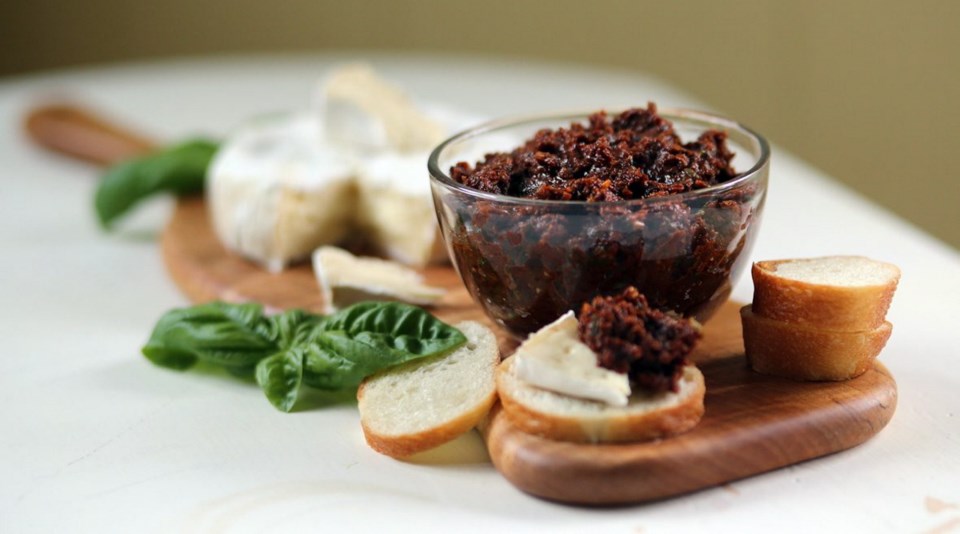 Dear Eric: When visiting Provence, we would visit markets where they sold sun-dried tomato spread that we would buy and spread on baguettes. It was so flavourful; I bought it every chance I got. I have tried a couple of recipes since returning, but they were never the same as that rich, red spread. It was thick, with what I think was olive oil and possibly nuts, but I am not sure. Any ideas on how to make it?
Dear Eric: When visiting Provence, we would visit markets where they sold sun-dried tomato spread that we would buy and spread on baguettes. It was so flavourful; I bought it every chance I got. I have tried a couple of recipes since returning, but they were never the same as that rich, red spread. It was thick, with what I think was olive oil and possibly nuts, but I am not sure. Any ideas on how to make it?
Cindy
Dear Cindy: When I visited markets in France, I, too, bought and enjoyed the spread you described. It was sold in vats and you could purchase as much as you wanted.
At those markets, the vendors selling it labelled it confinade. Beside it, they sold tapenade and that provides a clue as to how it is made.
Olives are main ingredient in tapenade, but the meaning of that word indicates there’s more to it than that.
As I noted in a past article on tapenade, according to the book Jacques Pepin’s Table, the word for it comes from tapeno, which means “capers” in Provence, southern France, from where tapenade originates.
Capers were taken to that part of the world from Crete centuries ago and initially were preserved in olive oil. As they sat in that oil, they became fused together and formed a kind of paste of tapeno, thought to be the first crude version of tapenade.
Eventually, olives got blended with that caper/oil mixture and took over as tapenade’s main ingredient. Other flavourings were also added, such as garlic, herbs and anchovies.
According to some French-speaking friends of mine, the French word “confinade” means spread or paste. Tomato confinade is a spread made with sun-dried tomatoes that are blended and flavoured, as tapenade would be.
It’s rich-tasting and great to spread on a baguette, as Cindy noted, and tastes even better if you add some creamy cheese, such as goat, Brie or Camembert. I like to serve that combination of things as a summer appetizer with rosé wine.
The sun-dried tomatoes I used to make my confinade were dry-pack, meaning they were not sold in jars packed in olive oil. In France, you can buy them right at the market. In Canada, though, you’ll find them sold in bulk or in bags at most supermarkets.
Before turning them into confinade, you’ll need to soak them in boiling water 30 minutes or so to rehydrate them and make them soft enough to blend.
The sun-dried tomatoes I was able to purchase were not as richly red as the type I saw for sale in France, hence my confinade is a little darker that what I saw in that country. I also made mine a little coarser in texture but, Cindy, you could make yours smoother by blending it a little longer with a bit more olive oil, or with a touch of the water you soaked the tomatoes in.
Tomato Confinade
This tasty spread, with sweet, salty, herbaceous and tangy flavours, is great spooned on sliced baguette with some creamy cheese, such as goat, Brie or Camembert.
Preparation time: Five minutes, plus soaking time
Cooking time: None
Makes: About 11Ú4 cups
3 1/2 oz. (100 grams) dry-pack (not in oil) sun-dried tomatoes (see Note)
2 1/2 cups boiling water
1 tsp finely grated lemon zest
1 Tbsp lemon juice
1 Tbsp capers
2 large garlic cloves, thinly sliced
4 anchovy fillets
1/4 cup coarsely chopped fresh basil
1/4 cup extra-virgin olive oil, plus more as needed
• freshly ground black pepper to taste
• salt to taste
Place the tomatoes in a medium bowl and cover with the boiling water. Let the tomatoes stand 30 minutes or until rehydrated and softened.
Once softened, drain the water from the tomatoes and then place the tomatoes in a food processor. Add the lemon zest and juice, capers, garlic, anchovies, basil, oil and pepper. Pulse ingredients until well combined, but still slightly coarse in texture. Taste the mixture and season with salt, if needed. Also add a little more oil if you find the mixture too thick. Pulse the mixture a few seconds more.
Transfer the tomato confinade to a tight-sealing container and refrigerate until needed. It will keep at least two weeks. Warm the confinade to room temperature before serving drizzled, if desired, with a little olive oil.
Note: Dry-pack, sun-dried tomatoes are sold in bulk or in bags at most supermarkets. Three-and-a-half ounces (100 grams) of them equal about 1 1Ú2 cups.
Eric Akis is the author of The Great Rotisserie Chicken Cookbook (Appetite by Random House). His columns appear in the Life section Wednesday and Sunday.



